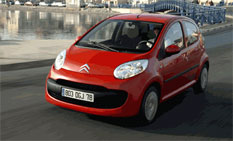Review
The collaboration with Peugeot (107) and Toyota (Aygo) will see each brand develop a small car on a single platform and build it at a new £1 billion factory in the Czech Republic to the tune of 300,000 units per year, with each brand getting an equal share for its European markets.
But Alain Favey, Citroen UK managing director, said: ‘France, Spain and Italy are dominant markets for cars like the C1 and so they will get the vast majority of our allocation. The supermini segment in the UK isn’t comparable so numbers will be limited.’
UK numbers in the first year will be a maximum of 2,000 – from which the dealer network will take demonstrators.

Favey said: ‘When you consider we sell 40,000 Picassos and 20,000 C3s, the C1 is still not going to be a huge seller or a significant player in fleet.’
The low numbers should, he said, prove to Citroen’s advantage on one issue of contention surrounding the manufacturing triumvirate.
There have been warnings of confusion in the fleet market appraising three similar models from three manufacturers. Favey believes the C1’s limited numbers will boost its residual value.
‘We should benefit from its scarcity,’ he said. ‘Just look at the Honda Jazz. Honda could have sold many more than it could get hold of, yet is now enjoying strong residual values.’
Prices have not yet been revealed, although Citroen says that with the Peugeot 107 priced from £6,995 at launch next month, the C1 will be ‘competitive’.
Favey, however, said at the car’s launch in Marseille that the C1 would not be available with Citroen’s usual cashback offers. He said: ‘This is a collaborative project. There would be no point in a price war. We’d only offer the C1 with cashback if Peugeot or Toyota did the same and I don’t think that is likely.’
The C1 goes on sale on June 1, sharing the same platform, front doors and windscreen as the French 107 and Japanese Aygo.
It will be the entry vehicle to the Citroen range and joins the C2, C3 and C3 Pluriel in the French manufacturer’s supermini line-up.
It will be available in three-door and five-door versions and is powered by either a 68bhp 1.0i three-cylinder Toyota petrol engine with variable valve timing or the 55bhp HDi diesel engine developed by PSA Peugeot Citroen.
Both will be offered with a five-speed manual gearbox, while the petrol version will also be available with a SensoDrive semi-automatic five-speed gearbox.
Safety features include front airbags (the passenger one can be switched off when a child seat is fitted), side airbags in the front seats, two curtain airbags and a warning buzzer which sounds if the driver moves off without putting a seatbelt on.
And in an effort to enhance its already admirable crash test rating (the existing supermini range has all achieved four-star EuroNCAP ratings) the C1 is fitted with two impact absorbers on the front and the shape and lining of the bonnet have been shaped to minimise risk of injury in a pedestrian collision.
More detailed specification and equipment levels will be announced at launch.
Behind the wheel
THE beauty of this joint venture is that PSA and Toyota can cherry-pick from each other’s technical expertise, so the C1 comes with the Japanese manufacturer’s petrol engine and Peugeot’s clean diesel.
I drove the 1.0-litre petrol five-speed manual on the launch and it proved an able performer, ideally suited to inner city driving, but coping admirably on open roads too, with the distinctive hum of the three-cylinder engine proving a satisfactory soundtrack and returning a creditable 61.4 combined mpg.
The driving position is comfortable even for six-foot-plus drivers and there is room in the back for similarly lofty companions, at a push.
Build quality is good and materials of a standard that belies the C1’s predicted budget pricing.
Individuality in this supermini collaboration comes through design. Citroen has deliberately gone for a quirky design for the car, particularly on the inside and the rear.
Outside it has high-mounted bulbous headlights, a high curving roof and a triangular rear light cluster. Inside there is a barrel-shaped centre display with rev counter attached, ball-shaped air vents, a three-spoke steering wheel and stereo and climate control units which hug the centre console.
Driving verdict
ALLIED to two good engines, a comfortable ride and adequate interior space, the C1 is a worthy addition to Citroen’s range. Its design is appealing and could prove a winning factor in the battle against the 107 and Aygo.
But being a good car is irrelevant if there aren’t enough cars available to satisfy demand although it protects residual values, which is just as important.
Citroen C1 factfile:
| Model: | 1.0i | 1.0i SensoDrive | 1.5 HDi | |||
| Engine (cc): | 998 | 998 | 1,398 | |||
| Max power (bhp/rpm): | 68/6,000 | 68/6,000 | 55/4,000 | |||
| Max torque (lb-ft/rpm): | 68/6,000 | 68/6,000 | 96/4,000 | |||
| Max speed (mph): | 98 | 98 | 96 | |||
| 0-62 (mph): | 13.7 | 14 | 15.6 | |||
| Combfuel consumption (mpg): | 61.4 | 61.4 | 68.9 | |||
| CO2 emissions (g/km) | 109 | 109 | 109 | |||
| Transmissions | 5-sp man | Semi auto | 5-sp man | |||
| On sales: June 1 | Prices TBA | |||||
















